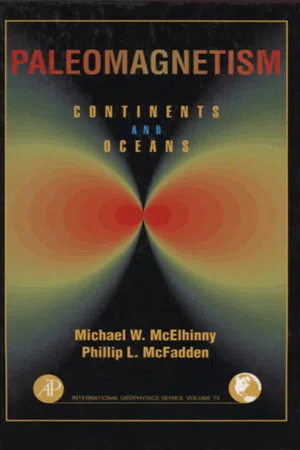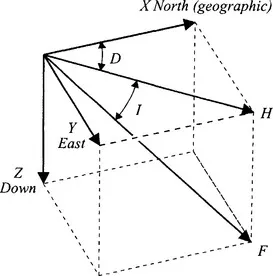1.1.1 Historical
The properties of lodestone (now known to be magnetite) were known to the Chinese in ancient times. The earliest known form of magnetic compass was invented by the Chinese probably as early as the 2nd century B.C., and consisted of a lodestone spoon rotating on a smooth board (Needham, 1962; see also Merrill et al., 1996). It was not until the 12th century A.D. that the compass arrived in Europe, where the first reference to it is made in 1190 by an English monk, Alexander Neckham. During the 13th century, it was noted that the compass needle pointed toward the pole star. Unlike other stars, the pole star appeared to be fixed in the sky, so it was concluded that the lodestone with which the needle was rubbed must obtain its “virtue” from this star. In the same century it was suggested that, in some way, the magnetic needle was affected by masses of lodestone on the Earth itself. This produced the idea of polar lodestone mountains, which had the merit at least of bringing magnetic directivity down to the Earth from the heavens for the first time (Smith, 1968).
Roger Bacon in 1216 first questioned the universality of the north-south directivity of the compass needle. A few years later Petrus Peregrinus questioned the idea of polar lodestone deposits, pointing out that lodestone deposits exist in many parts of the world, so why should the polar ones have preference? Petrus Peregrinus reported, in his Epistola de Magnete in 1269, a remarkable series of experiments with spherical pieces of lodestone (Smith, 1970a). He defined the concept of polarity for the first time in Europe, discovered magnetic meridians, and showed several ways of determining the positions of the poles of a lodestone sphere, each method illustrating an important magnetic property. He thus discovered the dipolar nature of the magnet, that the magnetic force is both strongest and vertical at the poles, and became the first person to formulate the law that like poles repel and unlike poles attract. The Epistola bears a remarkable resemblance to a modern scientific paper. Peregrinus used his experimental data as a source for new conclusions, unlike his contemporaries who sought to reconcile observations with pre-existing speculation. Although written in 1269 and widely circulated during the succeeding centuries, the Epistola was not published in printed form under Peregrinus’ name until 1558.
Magnetic declination was known to the Chinese from about 720 A.D. (Needham, 1962; Smith and Needham, 1967), but knowledge of this did not travel to Europe with the compass. It was not rediscovered until the latter part of the 15th century. By the end of that century, following the voyages of Columbus, the great age of exploration by sea had begun and the compass was well established as an aid to navigation. Magnetic inclination (or dip) was discovered by Georg Hartmann in 1544, but this discovery was not publicized. In 1576 it was independently discovered by Robert Norman. Mercator, in a letter in 1546, first realized from observations of magnetic declination that the point which the needle seeks could not lie in the heavens, leading him to fix the magnetic pole firmly on the Earth. Norman and Borough subsequently consolidated the view that magnetic directivity was associated with the Earth and began to realize that the cause was not the polar region but lay closer to the center of the Earth.
In 1600, William Gilbert published the results of his experimental studies in magnetism in what is usually regarded as the first scientific treatise ever written, entitled De Magnete. However, credit for writing the first scientific treatise should probably be given to Petrus Peregrinus for his Epistola de Magnete; Gilbert, whose work strongly influenced the course of magnetic study, must certainly have leaned heavily on this previous work (Smith, 1970a). He investigated the variation in inclination over the surface of a piece of lodestone cut into the shape of a sphere and summed up his conclusions in his statement “magnus magnes ipse est globus terrestris” (the Earth globe itself is a great magnet). Gilbert’s work, confirming that the geomagnetic field is primarily dipolar, thus represented the culmination of many centuries of thought and experimentation on the subject. His conclusions put a stop to the wild speculations that were then common concerning magnetism and the magnetic needle. Apart from the roundness of the Earth, magnetism was the first property to be attributed to the body of the Earth as a whole. Newton’s theory of gravitation came 87 years later with the publication of his Principia.
1.1.2 Main Features of the Geomagnetic Field
If a magnetic compass needle is weighted so as to swing horizontally, it takes up a definite direction at each place and its deviation from geographical or true north is called the declination (or magnetic variation), D. In geomagnetic studies D is reckoned positive or negative according as the deviation is east or west of true north. In paleomagnetic studies D is always measured clockwise (eastwards) from the present geographic north and consequently takes on any angle between 0° and 360°. The direction to which the needle points is called magnetic north and the vertical plane through this direction is called the magnetic meridian. A needle perfectly balanced about a horizontal axis (before being magnetized), so placed that it can swing freely in the plane of the magnetic meridian, is called a dip needle. After magnetization it takes up a position inclined to the horizontal by an angle called the inclination (or dip), I. The inclination is reckoned positive when the north-seeking end of the needle points downwards (as in the northern hemisphere) or negative when it points upwards (as in the southern hemisphere).
The main elements of the geomagnetic field are illustrated in Fig. 1.1. The total intensity F, declination D, and inclination I, completely define the field at any point. The horizontal and vertical components of F are denoted by H and Z. Z is reckoned positive downwards as for I. The horizontal component can be resolved into two components, X (northwards) and Y (eastwards). The various components are related by the equations:
Fig. 1.1 The main elements of the geomagnetic field. The deviation, D, of a compass needle from true north is referred to as the declination (reckoned positive eastwards). The compass needle lie...

